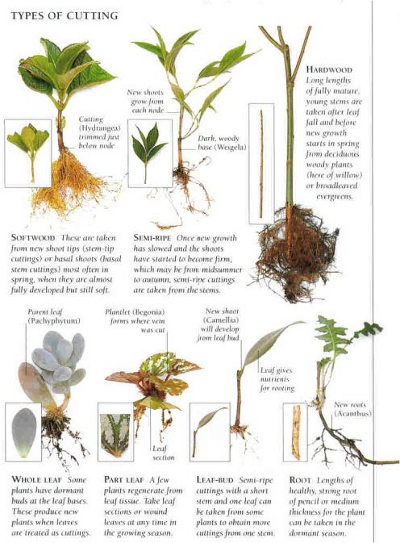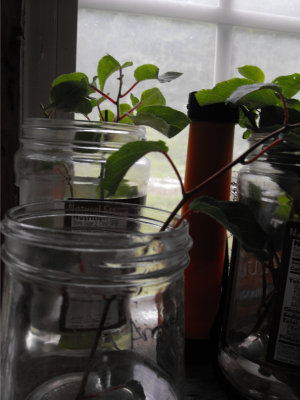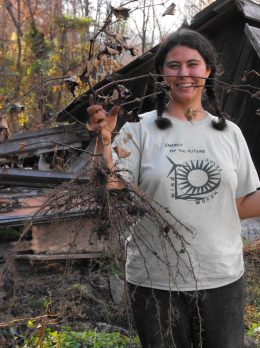
Types of cuttings
 I've
only taken two types of cuttings in the past, but it turns out there
are five options. Leaf cuttings are more often used with
non-woody plants, although if you want to root rhododendrons, magnolia,
red maple, or clematis, you may want to check out this technique.
The other seldom-used technique is root cuttings, which take a lot of
time and attention, so are often tried after all else fails.
I've
only taken two types of cuttings in the past, but it turns out there
are five options. Leaf cuttings are more often used with
non-woody plants, although if you want to root rhododendrons, magnolia,
red maple, or clematis, you may want to check out this technique.
The other seldom-used technique is root cuttings, which take a lot of
time and attention, so are often tried after all else fails.
The last three types are
all stem cuttings, which are
distinguished by the time of year at which you take the cutting.
The one I've found easiest is hardwood
cuttings, which
involve taking
six to twenty inches of last year's growth in the fall or winter (just
like you'd cut scionwood for grafting). It's
important to discard
the tips of the cuttings and to keep hardwood cuttings cool so
they don't start growing before roots form. (If the cuttings leaf
out too soon, they'll use up all the energy stored in the wood and then
die.) I'll write in a later post about techniques you can use to
increase your success rate, but in general, hardwood cuttings are
sometimes treated with rooting hormones, are sometimes callused, and
then are generally just stuck in the ground to go about their business.
Softwood cuttings are
more finnicky than hardwood cuttings, but this
method works on some species that don't respond well to the previous
method. Softwood cuttings are taken from tender wood that's newly
grown that spring, usually before it hardens to the point where you
can't bruise the twig with your fingernail. On the other hand,
you don't want  the cutting to be so tender
that it wilts
immediately. Time of year is also critically important, with a
few
species rooting from softwood cuttings throughout the growing season,
but with most refusing to respond after July or August. (The
authors of The
Manual of Woody Plant Propagation note that you will see much
better results for most species if you take the cutting as early as
possible.)
the cutting to be so tender
that it wilts
immediately. Time of year is also critically important, with a
few
species rooting from softwood cuttings throughout the growing season,
but with most refusing to respond after July or August. (The
authors of The
Manual of Woody Plant Propagation note that you will see much
better results for most species if you take the cutting as early as
possible.)
When taking softwood
cuttings, cut a two to five inch
piece of twig that includes several leaves, treat with rooting hormone
(usually), and be sure to keep the cutting moist with a misting
apparatus or humidity dome. You'll know when your cutting has
rooted because a gentle tug will meet with resistance --- at that
point, wean the plant off the mist (or the humidity dome), but keep it
in your nursery area for quite a bit longer. Some softwood
cuttings can be planted out the first fall, but most do better if you
overwinter them under protection and then plant in the spring, or even
let them stay in
rooting bed for two years. This is where I've had trouble with
softwood cuttings in the past --- I want to rush them out to the real
world, where they inevitably peter out and die.
The final type of
cutting is a semi-hardwood cutting, sometimes known as a greenwood
cutting. This is a niche technique, a bit like stem and root
cuttings, with most species responding better to either softwood or
hardwood cuttings. However, evergreens (both broadleaf and
needle) seem to enjoy greenwood cuttings. To take a greenwood
cutting, cut your twigs after the wood has firmed up, the leaves have
matured, and growth has ceased, usually between mid July and early
September. Remove the tip if it's soft,  then
cut your twig down to three to six inches long and remove leaves from
the lower half. Wounding (which I'll cover in a later post) is
sometimes used to promote rooting, and hormones are usually used, as
well as mist. Greenwood cuttings usually root in one to three
months.
then
cut your twig down to three to six inches long and remove leaves from
the lower half. Wounding (which I'll cover in a later post) is
sometimes used to promote rooting, and hormones are usually used, as
well as mist. Greenwood cuttings usually root in one to three
months.
Each kind of plant
responds well to one or more method of rooting, so it's useful to do a
bit of research before choosing your technique. If you have a
choice, though, I recommend trying out hardwood (and now's a good time
to do so). I'm experimenting with rooting grapes, mulberries,
figs, and gooseberries this winter and know that at least the first
will do well since I've had success with them before.
| This post is part of our Reference Manual of Woody Plant Propagation
lunchtime series.
Read all of the entries: |
Want more in-depth information? Browse through our books.
Or explore more posts by date or by subject.
About us: Anna Hess and Mark Hamilton spent over a decade living self-sufficiently in the mountains of Virginia before moving north to start over from scratch in the foothills of Ohio. They've experimented with permaculture, no-till gardening, trailersteading, home-based microbusinesses and much more, writing about their adventures in both blogs and books.
Want to be notified when new comments are posted on this page? Click on the RSS button after you add a comment to subscribe to the comment feed, or simply check the box beside "email replies to me" while writing your comment.
